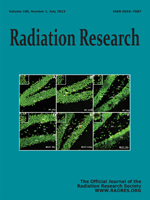The carcinogenic risk of high-charge and energy (HZE) particle exposure arises from its ability to both induce complex DNA damage and from its ability to evoke deleterious, non-DNA targeted effects. We investigate here whether these nontargeted effects involve dysregulation of double-strand break repair, such that a history of HZE exposure heightens the risks from future injury. We used a new human cell reporter line, in which expression of the I-SceI meganuclease stimulates both translocations on different chromosomes, and deletions on the same chromosome. Exposure to 1.0 Gy of 600 MeV/u 56Fe ions led to a doubling in the frequency of I-SceI-mediated translocations and a smaller, but nevertheless significant, increase in the frequency of I-SceI-mediated deletions. This mutagenic repair phenotype persisted for up to two weeks and eight population doublings. The phenotype was not induced by low-linear energy transfer radiation or by a lower dose of HZE-particle radiation (0.3 Gy) indicating that the effect is radiation quality and dose dependent. The mutagenic repair phenotype was associated with the presence of micronuclei and persistent DSB repair foci, consistent with a hypothesis that genomic stress is a causative factor.
How to translate text using browser tools
21 May 2013
Increased Mutagenic Joining of Enzymatically-Induced DNA Double-Strand Breaks in High-Charge and Energy Particle Irradiated Human Cells
Zhentian Li,
Farlyn Z. Hudson,
Huichen Wang,
Ya Wang,
Zhuan Bian,
John P. Murnane,
William S. Dynan
ACCESS THE FULL ARTICLE

Radiation Research
Vol. 180 • No. 1
July 2013
Vol. 180 • No. 1
July 2013




